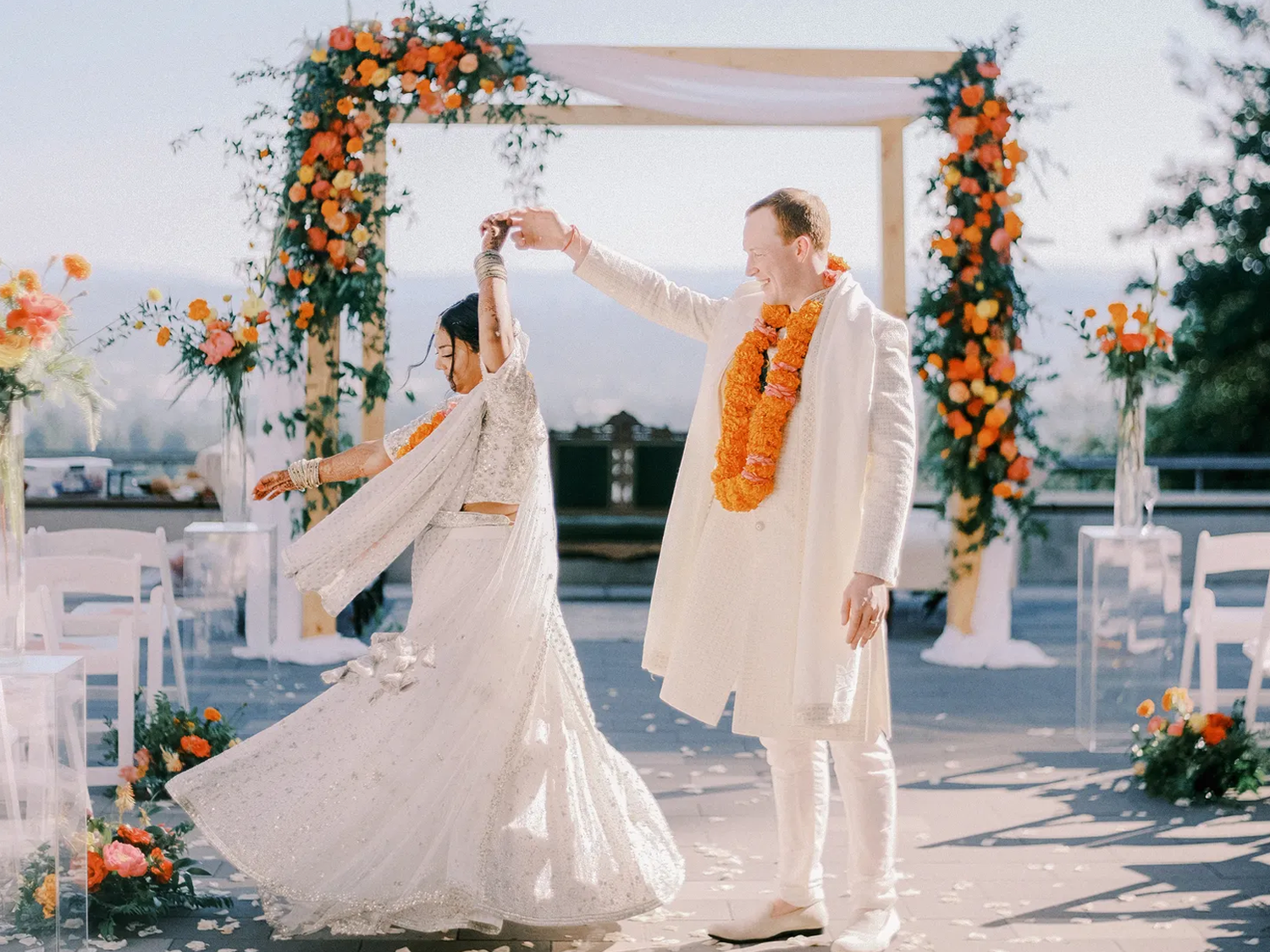Expert-Approved Budgeting Tips for How to Save on Wedding Flowers

From tall centerpieces to hand-tied bouquets, the cost of your wedding flowers can quickly add up. If you're keeping a close eye on your wedding budget (who isn't?), you might be wondering how to save on wedding flowers—or whether it's even possible to get the best of both worlds. According to our internal data, the average cost of wedding flowers in 2023 was $2,800, and 13% of couples were willing to increase their wedding budget to get the flowers they want. With a little creativity, planning and compromise, you can get the most bang for your buck and decorate with wedding flowers on a budget, all while staying true to your personal style. We asked expert wedding planners for their ideas and professional advice on how to save money on wedding flowers so that you're set up for success ahead of your wedding florist consultation.
Be honest and realistic about your budget upfront.
The first and best way to save money on wedding flowers is to be honest with yourself (and your vendors) from the very start. No matter the budget, it's important to hire a wedding florist that aligns with your wedding goals and vision. Keep this in mind when you're browsing reviews of potential florists on The Knot Vendor Marketplace, where you can sort results by budget, style, design elements and more. The florist you choose should be comfortable working within your budget and willing to guide you on the best decisions for your needs based on their previous experience. Checking all of these boxes before moving forward with an official florist contract will help you avoid disappointment, miscommunication, or buyer's remorse about your wedding flowers later on. "It is absolutely critical to share your desired investment or ballpark budget with the florist," says Emily Coyne, certified wedding and event planner and founder of Emily Coyne Events. "Doing so will save you (and them) time and will allow them to suggest the best designs and specific blooms for your budget."
At the initial consultation, share as many guidelines as you feel necessary, and remember that pictures are worth a thousand words, says Coyne. The florist will create a design proposal or mockup to give you an idea of what the flowers will look like, taking your budget and needs into consideration. Use The Knot Budget Tool to explore vendor price estimates near your wedding location. From there, you can modify, downsize or reevaluate the arrangements—but the most important thing is to establish strong communication and trust with your florist. "The biggest frustrations couples experience when selecting a florist typically arise because there was not enough transparency surrounding the vision and budget," Coyne says.
Invest in flower arrangements for high-visibility areas.
When you're working with limited funds or trying to get the most out of your flower budget, nearly any pro will recommend focusing your spend on certain areas for maximum impact—even if that means skipping out on smaller details elsewhere. "Prioritize spending on high-visibility areas that will stand out to guests and in photos, like the bouquet, altar and tablescape, to make the most of the budget," says Cameron Forbes, founder of Forbes Functions, a boutique event planning company based in New York City.
Instead of using your flower budget to get as many arrangements as possible, be frank about where people will really be spending the most time, and double-down on decorating those key areas. Secondary arrangements for transient areas like the bar, restrooms and venue entrance are nice to have, but you'll get more bang for your buck by prioritizing flowers for other focal areas where guests are more likely to linger. Reception centerpieces are a good example of where to invest, says Coyne. "Focus your spend on the florals that guests will see most closely: the dinner tables," she explains. "This is where guests stay for the longest period of time in one place and are inches away from the flowers." Another good investment? The wedding bouquet (if you're carrying one), since it will be in almost all of your wedding photos.
Focus on in-season flowers and bulk blooms.
You might have already heard that using locally sourced, in-season wedding flowers can help you save money. Most industry pros would agree—although it does depend slightly on your location and desired look. "Floral costs can fluctuate throughout the year based on what is in season and what must be imported," says Coyne. For the most part, in-season flowers are the freshest and most affordable blooms, because the costs go down when supply goes up. And if your florist is able to source the flowers locally, you can potentially avoid pricey overhead charges for long-distance shipping and transportation. Even if you're not getting married where there are a ton of local flower options, you can still get ahead of the budget game by using flowers that are in bloom during your wedding season—tulips from Holland are much easier (and cheaper) to source when they naturally bloom in April, compared to higher costs you'd encounter for special orders during the fall and winter seasons.
And speaking of special orders, flowers that aren't in-season at the time of your wedding (or flowers that are generally considered more rare) can quickly add zeros to your final bill. That's because your florist will have to find a specialty grower or supplier, which could be in another state—or country—adding fees for labor and transportation. After in-season flowers, your second-best option to save money on wedding flowers is to choose from widely available, year-round blossoms, like roses, carnations and orchids.
Finally, maximize your budget by limiting the number of different flower varieties in your arrangements. If your florist only needs to source a couple of flower varieties, the flowers can be purchased in bulk, which saves you money down the line.
Prioritize multi-use flower arrangements.
As the saying goes, two is better than one, especially when that means getting the most use out of your wedding flowers. "Consider repurposing your arrangements, like using your ceremony flowers for the reception, to maximize their usage," says Forbes. Your florist can recommend realistic ways to repurpose the flowers from the ceremony and reception, depending on your exact needs and designs. One idea that Coyne suggests is to use your ceremony aisle markers to decorate the front of the room or head table at the reception. Altar arrangements and ceremony arches are also fairly easy to repurpose in the second half of the day. "I would suggest always investing in your altar for the ceremony," says Nicole Day, owner and creative director of event planning company Ember & Stone Events. If you want flower arrangements that can pull double-duty, be sure to discuss everything with your florist in advance, Day recommends. "This can be a cost saver, but it can also increase the cost of items because of the additional labor required. So really looking at both prices is super important."
Account for labor fees and set-up costs.
When it comes to your wedding flower bill, you aren't just paying for the flower arrangements themselves. You're also paying for the florist's time and talent, and the amount will vary depending on how long they've been in business, where you're getting married and how much work is involved. "The type, scale, design and delivery of wedding flowers all impact the cost," explains Forbes. She adds that complex arrangements, like hanging centerpieces, full flower arches and other oversized installations require more time and skill to create, increasing the cost of labor. This is especially true if most of the work has to be done at your venue instead of the florist's design studio, because they'll need to pay for design assistants and other staff to help them on location. Even simple centerpieces will require wedding day delivery and setup, so it's important to be aware of those fees before making your final design decisions.
Use large-scale flowers to fill out the designs.
It might seem counterintuitive, but strategic splurging is actually another way to save money on wedding flowers. What do we mean by this? Flowers that are larger in size (like hydrangea bunches) or flowers that command attention (like phalaenopsis orchids) will pack a bigger punch in your wedding arrangements. This means that you can get away with using fewer flowers overall in those designs, allowing the statement flowers to really shine. Coyne recommends using this trick as a way to save money on your wedding party flowers. Instead of standard bridesmaid bouquets or boutonnieres, her tip is to use single-stem statement flowers, which she says will look more purposeful.
Incorporate non-floral elements to balance out your decor.
Fresh flowers can be the grounding elements of your wedding decor, but you don't need to stop there. Maximize the impact of basic centerpieces by pairing them with linens and other details to complement the overall wedding vibe. "Don't skimp on your tabletop elements," says Coyne. "If the flatware, chargers, linens, chairs and glassware all support the vision, then you'll have a much more elevated look, even if the flowers are sparse."
Day agrees, specifically calling out the use of unique wedding lighting and elements inspired by your wedding location, for example seashells you collected at the beach or mossy accents to tie into a forest venue. Finally, use candles in your centerpieces to create visual depth and add layers, especially if the flower arrangements are on the smaller side. "Purchasing inexpensive pillar candles and glass hurricane holders at different heights is an easy and affordable way to create ambiance," says Forbes.
A professional wedding planner can work in tandem with your florist to design cohesive tablescapes within your budget. And remember that all of the tables don't need to be exactly the same—you can prioritize flowers for the head table and other VIP tables, while cutting back on arrangements for others. "If some of your tables don't have flowers on them, that's okay," Day says. "Including candles and other decor into your overall reception and ceremony design can go so far when it comes to the look of things."
Downsize your wedding party flower arrangements.
If there's one piece of advice that all of our experts shared about how to save money on flowers for your wedding, it's this. The cost of wedding party flowers like bouquets, boutonnieres, corsages and flower girl crowns can add a lot to your bottom line, particularly if you have a large group. A single bridesmaid bouquet can cost between $50 to $100 depending on the design, while a groomsmen boutonniere is usually in the $20 to $30 range. In order to reallocate that money toward bigger arrangements, it's okay to downsize and simplify the wedding party flowers a little—or a lot. "They have them for such a small period of time and get way too roughed up to be utilized anywhere else," says Day. Ask your wedding florist for alternative, affordable options like single-stem bouquets or greenery boutonnieres that will serve their purpose while also being budget-friendly.
Please note: The Knot and the materials and information it contains are not intended to, and do not constitute, financial or tax advice and should not be used as such. You should always consult with your financial and tax advisors about your specific circumstances. This information contained herein is not necessarily exhaustive, complete, accurate or up to date and we undertake no responsibility to update. In addition, we do not take responsibility for information contained in any external links, over which we have no control.



























